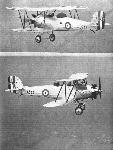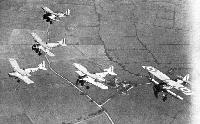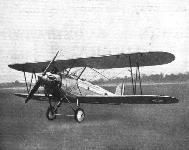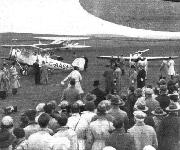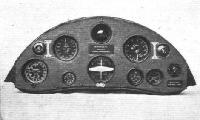
Описание
Страна : Великобритания
Год : 1928
Двухместный самолет базовой летной подготовки
Hawker Tomtit
Когда в 1927 году Министерству авиации потребовался простой учебно-тренировочный самолет для замены устаревшего Avro Type 504, Сидни Кэмм спроектировал изящный двухстоечный биплан с одинаковым размахом крыльев. Самолет имел традиционную аэродинамическую схему, открытые тандемные кабины для инструктора и курсанта, неубирающееся шасси с хвостовым костылем и звездообразный двигатель Armstrong Siddeley Mongoose. Прототип нового самолета совершил первый полет в ноябре 1928 года. Силовая конструкция самолета была металлической, обшивка - из полотна. Спустя три месяца после первого полета британские ВВС заказали 25 самолетов (включая прототип) для Центральной летной школы и 3-й летной школы. Два экземпляра были поставлены также Канаде и четыре - Новой Зеландии. В британских ВВС самолеты Tomtit Mk I поступили на вооружение в 1930 году, но с 1932 года были заменены самолетами Avro Tutor, после чего использовались только в качестве связных. В конце 1935 года большинство самолетов были списаны, так как их оказалось больше требуемого количества. Пять самолетов приобрели частные владельцы, выбравшие различные варианты силовой установки мощностью от 105 л.с.до 198 л.с.
ТАКТИКО-ТЕХНИЧЕСКИЕ ХАРАКТЕРИСТИКИ
Hawker Tomtit Mk I
Тип: двухместный самолет базовой летной подготовки
Силовая установка: один звездообразный ПД Armstrong Siddeley Mongoose IIIC мощностью 150 л.с. (112 кВт)
Летные характеристики: максимальная скорость на уровне моря 200 км/ч; начальная скороподъемность 305 м/мин; набор высоты 3050 м - за 14 мин 30 с; практический потолок 5945 м; дальность 563 км
Масса: пустого 499 кг; максимальная взлетная 794 кг
Размеры: размах крыльев бипланной коробки 8,71 м; длина 7,21 м; высота 2,54 м; площадь крыльев 22,09 м2
Описание:
- Hawker Tomtit
- Flight, January 1929
THE NEW HAWKER "TOMTIT" TRAINING MACHINE - Flight, June 1929
BRITISH AIRCRAFT AT OLYMPIA
Фотографии
-
Мировая Авиация 153
Регистрационный номер: K1786 [24], G-AFTA [24] Tomtit получил специальное оборудование "Reid and Sigrist" для тренировки "слепого" пилотирования, что сделало его превосходным учебным самолетом. Данный самолет принадлежал летной школе в середине 1930-х годов.
-
Air Enthusiast 1998-07 / D.Henley - Then there was one...
Регистрационный номер: K1786 [24], G-AFTA [24] From 36 to one. Shuttleworth's sole-surviving Tomtit K1786 delights crowds at both its home base, Old Warden, and at other venues.
-
Aeroplane Monthly 1979-05 / A.Jackson - Hawker Tomtit /RAF Piston Trainers/ (5)
Регистрационный номер: K1786 [24], G-AFTA [24] Hawker Tomtit K1786, now flying with the Shuttleworth Collection at Old Warden.
-
Air Enthusiast 1998-07 / D.Henley - Then there was one...
Регистрационный номер: G-AFTA [24], K1786 [24] From 1959 G-AFTA maintained its Hawker house colours while with Shuttleworth. Following overhaul at Dunsfold in 1967 it took on military markings once more.
-
Aviation Historian 10
Регистрационный номер: G-AFTA [24], K1786 [24] Hawker Tomtit G-AFTA (the full-size aircraft is seen here at Old Warden in 1960), and finished it in the very same paint used on all the Hawker “heritage" aeroplanes.
-
Aviation Historian 5 / N.Stroud - The Last of the Many
Регистрационный номер: G-AFTA [24], K1786 [24] An extremely rare Dufaycolor transparency of G-AMAU at White Waltham on May 14, 1950, taken from beside the tail of Hawker's similarly-painted civil-registered Tomtit, G-AFTA. Unusually, this photograph was taken from the starboard side, revealing that the legend, "The Last of The Many", was painted only on the port side in the initial iteration of the Hurricane's blue-and-gold scheme.
Другие самолёты на фотографии: Hawker Hurricane - Великобритания - 1935
-
Aeroplane Monthly 1979-05 / A.Jackson - Hawker Tomtit /RAF Piston Trainers/ (5)
Регистрационный номер: J9772 [3] Tomtit prototype J9772 in its pale blue and silver Aero Show finish, July 1929.
-
Flight 1929-01 / Flight
Регистрационный номер: J9772 [3] A NEW TRAINING MACHINE: Three views of the Hawker "Tomtit" all-metal biplane. Note the pronounced stagger and slightly backswept wings. The engine is an Armstrong-Siddeley "Mongoose"
-
Air Enthusiast 1998-07 / D.Henley - Then there was one...
Регистрационный номер: J9772 [3] The Tomtit prototype J9772 while on charge with 24 Squadron at Hendon, July 1930 to May 1933. It then served briefly with the Air Defence of Great Britain Communication Flight at Northolt from December 1935 until January 1936 after which it is assumed to have been struck off charge.
-
Air Enthusiast 1998-07 / D.Henley - Then there was one...
Регистрационный номер: K1786 [24], G-AFTA [24] When K1786 performs, the audience is treated to a delightful combination - Hawker biplane and Armstrong Siddeley Mongoose IIIC five-cylinder radial.
-
Aeroplane Monthly 1985-05 / Grapevine
Регистрационный номер: K1786 [24], G-AFTA [24] On March 19, 1985 Hawker Tomtit K1786 of the Shuttleworth Collection took to the air again for the first time since August 29, 1982. It had been grounded for a thorough overhaul of its Armstrong Siddeley Mongoose engine and for re-covering of its wings. Shuttleworth engineer Chris Morris reports that the engine has been fitted with “better” pistons - as distinct from new pistons which are somewhat scarce - and new piston rings. During two hours of ground running the engine speed was built up from 800 to 1,400 r.p.m., at which point Dicky Martin (seen in the cockpit of K1786) “tickled the aircraft off the ground” (usual take-off r.p.m. is 1,650) and took it for a 30min flight around the Old Warden circuit. A further flight was due to be made as soon as suitable weather arrived.
-
Air-Britain Archive 1981-04
Регистрационный номер: K1786 [24], G-AFTA [24] The sole remaining Hawker Tomtit, G-AFTA now flies at Old Warden in its original identity as K1786. It received its first C of A on 28.4.39 and was flown by the legendary Alex Henshaw and Neville Duke. Here it taxis out at the Shuttleworth Display on 31.7.77.
-
Flight 1929-01 / Flight
THE HAWKER "TOMTIT" IN FLIGHT: Mr. Bulman shows various aspects of the new training machine
-
Flight 1929-07 / Flight Advertisements
The Hawker "TOM-TIT" Training machine with Armstrong Siddeley Mongoose engine, now in production for the Royal Air Force.
-
Flight 1929-07 / Flight
HAWKER "TOMTIT" (A.S. "Mongoose").
-
Air-Britain Archive 1985-04
Регистрационный номер: K1786 [24], G-AFTA [24] The Shuttleworth Trust's Hawker Tomtit G-AFTA performing at Old Warden in April 1971.
-
Aeroplane Monthly 1974-09 / News Spotlight
Регистрационный номер: K1786 [24], G-AFTA [24] Hawker Tomtit K1786 in spirited mood.
-
Aeroplane Monthly 1979-05 / A.Jackson - Hawker Tomtit /RAF Piston Trainers/ (5)
Регистрационный номер: K1786 [24], G-AFTA [24] The sole surviving Tomtit, K1786/G-AFTA, now with the Shuttleworth Trust.
-
Aeroplane Monthly 1981-02 / Hawker Tomtit K1786/G-AFTA /Preservation Profile/
Регистрационный номер: K1786 [24], G-AFTA [24] -
Aeroplane Monthly 1979-05 / A.Jackson - Hawker Tomtit /RAF Piston Trainers/ (5)
Регистрационный номер: J9774 J9774 from the first production batch, photographed in October 1929.
-
Aeroplane Monthly 1979-05 / A.Jackson - Hawker Tomtit /RAF Piston Trainers/ (5)
Регистрационный номер: J9777 [6] After serving with the CFS, Tomtit J9777 was destroyed in a takeoff collision with Siskin J9190 on July 14, 1931, while with No 3 FTS.
-
Flight 1932-05 / Flight
Регистрационный номер: J9777 [6] FITTED FOR "BLIND" FLYING: The Hawker "Tomtit" (Armstrong-Siddeley "Mongoose" engine) has a hood over the rear cockpit, used for teaching flying entirely by instruments.
-
Air Enthusiast 1998-07 / D.Henley - Then there was one...
Регистрационный номер: J9777 [6] Delightful air-to-air portrait of J9777. This aircraft initially served with the Central Flying School at Wittering from 1929, joining 3 FTS in December that year. It was destroyed in a collision with a Siskin at Grantham in July 1931.
-
Flight 1929-11 / Flight
Регистрационный номер: J9777 [6] THE HAWKER "TOMTIT": A training machine of recent production, incorporating several unusual features. For instance, it is fitted with a special type of Reid turn indicator, and other instruments which permit the pupil to be trained in flying solely by instruments. For this purpose the hood over the back cockpit is closed, cutting out the view entirely. These two illustrations show the machine with hood closed and with hood open. The engine is a "Mongoose."
-
Flight 1930-07 / Flight
Регистрационный номер: J9777 [6] AN all-metal training machine (two seater) with Armstrong-Siddeley "Mongoose" engine. In the King's Cup Race, one ol these machines (No. 33) has been entered by the Prince of Wales.
-
Aeroplane Monthly 1983-12 / L.Coombs - Cockpits of the RAF (3)
Регистрационный номер: J9777 [6] Hawker Tomtit J9777 with pupil under the “hood", and instructor peeping mischievously from beneath the wing.
-
Aeroplane Monthly 1979-05 / A.Jackson - Hawker Tomtit /RAF Piston Trainers/ (5)
Регистрационный номер: K1783 The Fleet Air Arm's Tomtit, K1783, with the badge of “C” Flight, Gosport, on its fin.
-
Flight 1933-08 / Flight
TRAINING TYPES: The machines from top to bottom are "Atlas," "Tutor," "Tiger Moth," "Tomtit" and "Siskin."
Другие самолёты на фотографии: Armstrong Whitworth Atlas / Ajax - Великобритания - 1925Armstrong Whitworth Siskin - Великобритания - 1921Avro Tutor/Sea Tutor/Prefect / Type 621/646/626 - Великобритания - 1929De Havilland Tiger Moth / D.H.82 - Великобритания - 1931
-
Aeroplane Monthly 1974-09 / News Spotlight
Регистрационный номер: K1786 [24], G-AFTA [24] Hawker Tomtit K1786 and DH Moth G-EBLV.
Другие самолёты на фотографии: De Havilland Moth / D.H.60 - Великобритания - 1925
-
Aeroplane Monthly 1979-05 / A.Jackson - Hawker Tomtit /RAF Piston Trainers/ (5)
Регистрационный номер: J9775 The fourth aircraft, J9775, with blind flying hood in position, at Brooklands in 1929 prior to delivery.
-
Aeroplane Monthly 1979-05 / A.Jackson - Hawker Tomtit /RAF Piston Trainers/ (5)
Регистрационный номер: J9782 J9782 as a communications aircraft of No 9 (Bomber) Squadron at the North Coates Fitties armament practice camp in 1929.
-
Air Enthusiast 1998-07 / D.Henley - Then there was one...
Регистрационный номер: J9776 [2] Line-up at Grantham, 1931, of 3 Flying Training School Tomtits. Nearest is J9776 ‘9’ which served with the FTS from April to November 1930, moving on to 24 Squadron in December 1931.
-
Flight 1929-08 / Flight Advertisements
Hawker "Tomtit" (Mongoose). The machine has been adopted as a standard training machine by the Royal Air Force. Like all Hawker machines, the "Tomtit" is doped with CELLON.
-
Aeroplane Monthly 1979-05 / A.Jackson - Hawker Tomtit /RAF Piston Trainers/ (5)
Регистрационный номер: J9776 [2] Three Tomtits of No 3 FTS lined up at RAF Grantham.
-
Flight 1929-07 / Flight
The Hawker Stand has the distinction of exhibiting three machines never hitherto seen in public: The "Tomtit" training machine, the "Hart" day bomber recently ordered in quantities for the R.A.F., and the "Hornet," believed to be the world's fastest single-seater fighter.
Другие самолёты на фотографии: Hawker Hart - Великобритания - 1928Hawker Hornet / F.20/27 - Великобритания - 1928
-
Aeroplane Monthly 1979-05 / A.Jackson - Hawker Tomtit /RAF Piston Trainers/ (5)
RCAF Tomtit 139 with ski-equipped split undercarriage at Camp Borden in the 1930s.
-
Flight 1930-07 / Flight
AT MRS. BALDWIN'S NATIONAL BIRTHDAY TRUST FUND MEETING AT HANWORTH: Sqd.-Ldr. Guest is seen finishing on his "Tomtit."
-
Flight 1932-05 / Flight
Регистрационный номер: G-AALL [2] The "scratch" man, F/O. E. C. T. Edwards, taking-off on his Hawker "Tomtit" (Mongoose III).
-
Aeroplane Monthly 1989-01 / Personal album. Civil
Регистрационный номер: G-AALL [2] Hawker Tomtit G-AALL was entered for the 1930 King’s Cup race by the Prince of Wales and flown by Sqn Ldr D. S. Don into 18th place. After the race it was sold to Diana Guest.
-
Aviation Historian 19 / P.Jarrett - The Hornet dilemma
Регистрационный номер: G-AASI [3] Bulman’s snapshot bears the handwritten inscription “Novi Sad 2 July 1931” on the reverse. The Tomtit is almost certainly G-AASI, and the nose of an inline-engined biplane with roundels is visible behind, on the right. Also on the back are the names of the individuals; from right to left, “Ludvig, Hayward, Osborn, Eales, Ferdo”.
-
Flight 1930-07 / Flight
Регистрационный номер: G-ABAX [5] THE TWO "TOMTITS": The Prince of Wales' machine in the lead, closely followed by Captain Guest's entry.
-
Aeroplane Monthly 1991-06 / J.Havers - Field of endeavour (2)
Регистрационный номер: G-AEVO Hawker Tomtit G-AEVO in which Field participated in the 1937 Isle of Man races. The Tomtit was fitted with an Armstrong Siddeley Mongoose engine.
-
Aeroplane Monthly 1999-10
Регистрационный номер: G-AEXC R.H.Statham’s father Hugh Statham, killed in November 1957 in a Britannia while deputy chief test pilot with Bristol, is in the leather coat at right. The aircraft is Hawker Tomtit G-AEXC, registered to the Herts & Essex Aero Club in August 1938 and scrapped during the war, and the photograph was probably taken at Broxbourne. Can anyone identify the other people?
-
Aeroplane Monthly 1991-06 / J.Havers - Field of endeavour (2)
Регистрационный номер: G-AFFL Hawker Tomtit G-AFFL about to be flagged off at the start of a race. In the background is the T.K.2 G-ADNO.
Другие самолёты на фотографии: De Havilland Technical School T.K.2 - Великобритания - 1935
-
Air-Britain Archive 1985-01
Регистрационный номер: G-AFIB Hawker Tomtit G-AFIB disposed off by the RAF, civilianised in 1938 and used by Alex Henshaw during the War ir camouflage and civil registration.
-
Aeroplane Monthly 1981-02 / Hawker Tomtit K1786/G-AFTA /Preservation Profile/
Регистрационный номер: G-AFTA [24], K1786 [24] Wartime photograph of Alex Henshaw’s Tomtit G-AFTA, with front cockpit faired over and fitted with a Spitfire windscreen. Tomtit bear RAF fin flashes and have their civil registration letter underlined with red, white and blue stripes.
-
Aeroplane Monthly 1981-02 / Hawker Tomtit K1786/G-AFTA /Preservation Profile/
Регистрационный номер: G-AFTA [24], K1786 [24] -
Aeroplane Monthly 1983-12 / D.Middleton - Neville Duke /Test Pilot Profile/ (8)
Регистрационный номер: G-AFTA [24], K1786 [24] Neville Duke flying Hawker's dark blue and silver Hawker Tomtit, now preserved by the Shuttleworth Trust.
-
Aeroplane Monthly 1981-02 / Hawker Tomtit K1786/G-AFTA /Preservation Profile/
Регистрационный номер: G-AFTA [24], K1786 [24] -
Air Enthusiast 1998-07 / D.Henley - Then there was one...
Регистрационный номер: G-AFTA [24], K1786 [24] G-AFTA in racing trim, 1951. Note the Spitfire windscreen and faired headrest from its days with Alex Henshaw.
-
Aviation Historian 5 / N.Stroud - The Last of the Many
Регистрационный номер: G-AFTA [24], K1786 [24] A formation flypast by Hawker’s Tomtit, Hart and Hurricane was a regular sight at British displays of the early 1950s, the Hawker test pilots frequently winning best-formation accolades and trophies. The speed ranges of the aircraft were quite different and a generous helping of flap was necessary to keep the Hurricane in tight formation. This flyby was captured at White Waltham on August 31, 1952.
Другие самолёты на фотографии: Hawker Hart - Великобритания - 1928Hawker Hurricane - Великобритания - 1935
-
Aviation Historian 5 / N.Stroud - The Last of the Many
Регистрационный номер: G-AFTA [24], K1786 [24] A regular sight at 1950s British airshows was Hawker’s fleet of Sydney Camm-designed aircraft, which comprised, from nearest to furthest, Hart G-ABMR (currently on display at RAF Museum Hendon), Tomtit G-AFTA (still airworthy with the Shuttleworth Collection), Cygnet G-EBMB (now at RAF Museum Cosford) and G-AMAU.
Другие самолёты на фотографии: Hawker Cygnet - Великобритания - 1924Hawker Hart - Великобритания - 1928Hawker Hurricane - Великобритания - 1935
-
Aeroplane Monthly 1991-06 / J.Havers - Field of endeavour (2)
Регистрационный номер: G-AFVV, K1784 Hawker Tomtit G-AFVV was built originally for the RAF as K1784 and was later owned by the Leicester Aero Club and Alex Henshaw in 1939. It was one of six Tomtits which Brian Field purchased from the Air Ministry and subsequently sold on the civil market.
-
Aeroplane Monthly 1991-06 / J.Havers - Field of endeavour (2)
Регистрационный номер: G-AGEF The one-time Gosport Tomtit in wartime camouflage as G-AGEF seen at Christchurch (Castle Bromwich ???) adjacent to the Airspeed factory in 1942. The aircraft was written off in October 1943 when owned by Vickers-Armstrongs Ltd. Tomtit bear RAF fin flashes and have their civil registration letter underlined with red, white and blue stripes.
-
Flight 1931-01 / Flight
One of types seen at Brooklands - the Hawker "Tomtit" (Cirrus "Hermes"), piloted by P. E. G. Sayer
-
Aeroplane Monthly 1979-05 / A.Jackson - Hawker Tomtit /RAF Piston Trainers/ (5)
Регистрационный номер: G-ABOD [2] G-ABOD at Brooklands in 1938 with the Wolseley Aquarius engine.
-
Air Enthusiast 1998-07 / D.Henley - Then there was one...
Регистрационный номер: G-ABAX [5] G-ABAX was one of five civilian Tomtits. It was fitted with a Wolseley AR.9 in 1935, as illustrated, hut retired in 1936 and was used for carburettor trials.
-
Aeroplane Monthly 1979-05 / A.Jackson - Hawker Tomtit /RAF Piston Trainers/ (5)
Регистрационный номер: G-AASI [3], G-ABAX [5], G-ABOD [2] THE HAWKER-WOLSELEY COMBINATION: The three Hawker "Tomtits" trying out their new Wolseley A.R.9 engines near Brooklands before the race.
Messrs Bulman, Sayer and Lowdell on their way from Brooklands to Hatfield for the 1933 King's Cup Race. -
Flight 1936-06 / Flight
Регистрационный номер: G-AASI [3] Interest at Ronaldsway after the finish of the London - I.O.M. Race. In the foreground are F/O. Hughesdon's Wolseley-engined Hawker Tomtit (2nd), Mr. Humble's single-seater Gipsy Six Hawk (3rd) and the D.H.86 flown by Mr. Higgins (4th).
Другие самолёты на фотографии: De Havilland Express Air Liner / D.H.86 - Великобритания - 1934Miles Hawk / M.2 - Великобритания - 1932
-
Flight 1936-08 / Flight
Lowdell low down: Mr. George Lowdell, who put up two masterly aerobatic displays, and his Hawker Tomtit in the act of strafing the clubhouse.
-
Flight 1933-07 / Flight
Регистрационный номер: G-ABAX [5] THE "TOMTIT" PILOTS: Left to right, P. E. G. Sayer, P. W. S. Bulman and G. E. Lowdell.
-
Flight 1933-07 / Flight
THE NEW WOLSELEY ENGINE: This is the first photograph to be published, and shows the engine in the Hawker "Tomtit," to be flown in the King's Cup Race by Mr. Sayer (No.8).
-
Flight 1929-07 / Flight
The folding hood of the Hawker "Tomtit," which is used for training pilots in flying entirely "by instruments."
-
Aeroplane Monthly 1985-07 / Grapevine
Регистрационный номер: K1786 [24], G-AFTA [24] Ten weeks after its first flight since an extensive overhaul and re-covering of the wings, Shuttleworth's Hawker Tomtit, K1786, was damaged in a landing accident at RAF Mildenhall on Sunday, May 26, 1985.
-
Air Enthusiast 1998-07 / D.Henley - Then there was one...
Регистрационный номер: K1786 [24], G-AFTA [24] A reminder of the frailty of aeronautical treasures. K1786 suffered a forced-landing during the airshow at Mildenhall in May 1985.
-
Aviation Historian 10
Регистрационный номер: G-AFTA [24], K1786 [24] Following publication of our article on Hawker Hurricane PZ865’s post-war racing career in TAH5, Chris Farara and Dick Poole alerted us to the fact that the late David Lockspeiser had built a 1/72nd-scale model of Hawker Tomtit G-AFTA, and finished it in the very same paint used on all the Hawker “heritage" aeroplanes. TAH has borrowed the model from David’s family, to examine the colour - which is close to Methuen 20F8, and just a touch lighter than Humbrol 15 Gloss Midnight Blue.
-
Flight 1929-07 / Flight
Typical fuselage details of Hawker "Tomtit" and other machines. Note the use of circular tubes, with flats formed on them.
-
Flight 1929-07 / Flight
On the Hawker "Tomtit." The neat sternpost arrangement and, below, a wing spar with strut fitting.
-
Air Enthusiast 1998-07 / D.Henley - Then there was one...
Hawker Tomtit I.
-
Flight 1929-07 / Flight
Hawker "Tomtit" Armstrong Siddeley "Mongoose" Engine
-
Aeroplane Monthly 1979-05 / A.Jackson - Hawker Tomtit /RAF Piston Trainers/ (5)
Hawker Tomtit of the Central Flying School, Wittering, October 1929
- Фотографии























